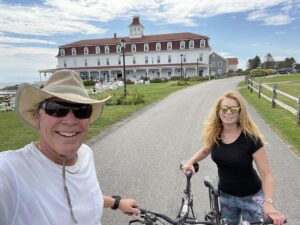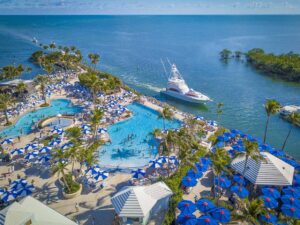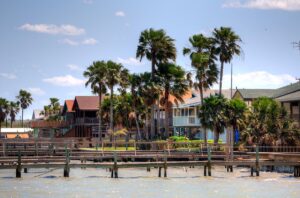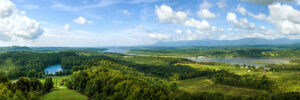Albemarle Sound is to many boaters, especially Intracoastal Waterway cruisers, just a body of water to be crossed in North Carolina. However, to local boaters or those who have taken the time to explore it, Albemarle Sound is a rich and diverse expanse.
The Albemarle is an estuary formed by the confluence of the Chowan and Roanoke rivers. The sound’s water is mostly brackish, with the fresh water of its rivers meeting the salt water of the Atlantic Ocean. The brackish water is bordered by thousands of acres of sea grass and coastal marshes, making the Albemarle a perfect habitat for a variety of marine life.
There are several ways a boater can enter the Albemarle: from the historic Dismal Swamp Canal or from the North River through Coinjock, N.C. Starting from the south, a weekend cruise can begin in the summer retreats of the Outer Banks through Manteo or from the ICW and the Alligator River. Regardless of where you begin, it is easy to spend a long weekend enjoying Albemarle Sound. There are many weekend cruises to choose from, but with a little extension to the weekend, towns such as Plymouth, Edenton and Hertford, all worthwhile destinations with their own unique charms and character, can be included in the itinerary.
Day One: Coinjock to Manteo – 35 nautical miles south
For boaters coming down from the Chesapeake Bay, the North River through Coinjock, N.C., is a great starting point. The first day’s route leaving Coinjock Marina to Manteo is through scenic woodlands, coastal marshes and the open sound. Manteo is located on Roanoke Island, the site of the first English settlement in North America, established in 1587, and what became known as the intriguing mystery of the Lost Colony. The story of the Lost Colony has been retold in a local award-winning outdoor drama that has run each summer since 1937.
Located at Roanoke Island Festival Park, just across the water from the Manteo Waterfront Marina, is a hand-built reproduction of the 16th-century square-rigged sailing ships that brought the colonists to Roanoke Island. The Elizabeth II is open for tours as is an interpretive center at the Roanoke Adventure Museum, also located in the park. The town of Manteo is on Shallowbag Bay, which offers various spring and summer activities. Kayaking is a perfect way to explore the area’s protected waters, and the fishing here is world-renowned, both off-shore and in the sound — red drum and spotted seatrout are especially popular. Manteo also has a plethora of shops scattered along the town center and many delectable restaurants, including the Full Moon Cafe´, the 1587 Restaurant, Poor Richard’s Sandwich Shop and Ortega’z Southwestern Grill.
Day Two: Manteo to Columbia – 40 nautical miles west
Columbia has held an important position on the banks of the Scuppernong River for centuries. An unspoiled natural beauty awaits visitors to Columbia, as the indigenous red wolf, the American alligator and a large population of bald eagles still roam free. Columbia is a nature lover’s paradise. Local and national interests have sought to preserve this pristine environment with conservation areas like the Pocosin Lake National Wildlife Refuge and the Palmetto-Peartree Preserve.
Columbia is also home to the world- famous Pocosin Arts, regarded as a premier center for ceramics, jewelry and textiles. Classes are offered for all ages for both beginning and experienced artists.
A visit to Columbia would not be complete without a visit to Vineyards on the Scuppernong. The winery is named for the river along which it has grown for years, and the local scuppernong grape is a hardy, sweet grape that has been used for winemaking for centuries. In 1584, Philip Amadas and Arthur Barlowe of Sir Walter Raleigh’s expedition reported that they had found “grapes of such greatness, yet wild, as France, Spain nor Italy hath no greater.”
Columbia has few marina options, including Cypress Cove Marina, just a mile from town, and Alligator River Marina, located along Alligator River and accommodating vessels up to 150 feet and with an onsite fuel dock. Elements Coffee Shop is a great place to grab breakfast in the morning when strolling through town. When it’s time for dinner, don’t miss the Old Salt Oyster Bar on historic Main Street.
Day Three: Columbia to Elizabeth City – 37 nautical miles northeast
Continuing our roughly clockwise rotation around the lower half of the Albemarle, our next stop is Elizabeth City. Compared with the quaint villages we’ve visited so far, Elizabeth City is a major metropolis. With an extensive waterfront position on the Pasquotank River, Elizabeth City was destined to play an important role on the Albemarle Sound. Its location made for a natural trading center, as the sound became an important inland water highway along the East Coast. With the completion of the Dismal Swamp Canal, Elizabeth City’s prominence at the southern terminus of the canal was cemented.
Dock right in town at Mariner’s Wharf, which has new comfort facilities with restrooms and showers and free WiFi. Venture across the street to Cypress Creek Grill for tasty Creole cuisine seafood dishes.
The city houses the largest Coast Guard Air Station in the country, so it is certainly friendly to boaters and their needs. The Coast Guard Station is also open for tours and well worth the time. Elizabeth City has a thriving arts and culture scene, topped off by the Museum of the Albemarle, which depicts life from 10,000 years ago to present day. Downtown there are six nationally registered historic districts, and there are many walking tours available. Don’t miss the Downtown Waterfront Market at Mariner’s Wharf Park every Saturday from 9 a.m. to 1 p.m.





